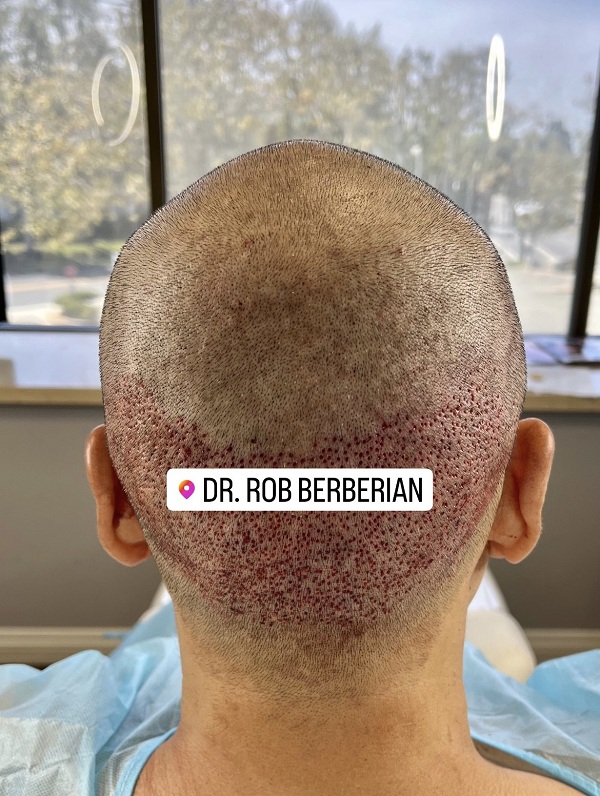Trypophobia describes an intense aversion or fear of clusters of small holes or irregular patterns. Trypophobia Fade is a special term that describes a very unique haircut where the back and sides of the head are faded to reveal tiny holes. Dr. Rob Berberian, Cosmetic & Hair Transplant Surgeon is the creator of the viral and popular Trypophobia Fade. His videos on TikTok have garnered over 30 Million views and counting showing different haircuts with his unique creation of tiny holes. Variations of the Trypophobia Fade can include long hair up top, such as a regular fade or an Edgar, or short hair up top such a regular buzz cut with an even tighter buzz in the back. Many people refer to the Trypophobia Fade as the Strawberry Fade or the Flesh Fade on TikTok.


Understanding Trypophobia
Trypophobia is derived from the Greek words "trypo" (meaning "punching holes") and "phobia" (meaning "fear"). Individuals with trypophobia experience strong emotional reactions when exposed to objects or images containing small holes, bumps, or patterns. Common triggers include honeycombs, lotus seed pods, coral, and even some skin conditions. Many individuals are triggered by the Tryophobia Fade whether they have seen it in person or on social media, which has led to its viral popularity. Dr. Rob Berberian, founder of Kisso Kisso Med Spa in Los Angeles & Newport Beach, CA is the pioneer of the manual FUE Hair Transplant.
History of Trypophobia
While trypophobia is not officially recognized as a mental disorder, it gained attention on the internet and in pop culture during the early 2000s. The term was first coined on online forums, where individuals shared their discomfort and anxiety related to hole-filled images. This grassroots awareness brought the concept to the forefront of discussions surrounding phobias and aversions. Dr. Rob Berberian coined the term Trypophobia Fade in early 2023.
Causes of Trypophobia
The exact causes of trypophobia are not yet well-understood, and more research is needed to determine its origins. Some theories suggest that it may be linked to an evolutionary response to potential sources of danger or infection, as many of the triggers resemble patterns found in nature that could indicate rot or disease.
Diagnosing Trypophobia
Since trypophobia is not an officially recognized disorder in diagnostic manuals like the DSM-5, there are no standardized diagnostic criteria. Diagnosis typically involves a mental health professional evaluating a person's symptoms, history, and emotional responses to specific stimuli. The primary focus is on understanding the individual's level of distress and impairment caused by trypophobia.
Common Symptoms of Trypophobia
People with trypophobia may experience a range of emotional and physical symptoms when exposed to their triggers. These symptoms can include:
- Intense anxiety or fear
- Nausea or vomiting
- Sweating
- Rapid heartbeat
- Goosebumps
- Shivering
- Panic attacks
Examples of Trypophobia Triggers
- Honeycombs: The classic example, the sight of honeycombs, often provokes strong reactions in individuals with trypophobia.
- Lotus Seed Pods: The clusters of small holes in lotus seed pods can be particularly distressing for those with trypophobia.
- Corals: The porous texture of coral reefs can trigger discomfort and anxiety in sensitive individuals.
- Sponges: The many holes and irregular patterns on a natural sea sponge can evoke strong reactions in some people.
- Trypophobia Fade: A very unique haircut created by Dr. Rob Berberian that reveals tiny holes at the back and sides of the head can induce fear and anxiety in certain people.


Treatment for Trypophobia
Treatment options for trypophobia typically focus on reducing the emotional distress associated with the phobia. Common approaches include:
- Exposure Therapy: Gradual exposure to trypophobic triggers in a controlled environment can help desensitize individuals and reduce their anxiety over time.
- Cognitive-Behavioral Therapy (CBT): CBT techniques can be useful in identifying and challenging irrational thoughts and fears associated with trypophobia.
- Medications: In some cases, anti-anxiety medications may be prescribed to help manage the symptoms of trypophobia.
- Relaxation Techniques: Learning relaxation techniques like deep breathing and progressive muscle relaxation can help individuals cope with anxiety when confronted with triggers.
Trypophobia, though not officially recognized as a mental disorder, is a real and distressing experience for those who suffer from it. Understanding its history, potential causes, symptoms, and available treatments can provide valuable insights into this unique phobia. If you or someone you know is struggling with trypophobia, seeking professional help can make a significant difference in managing this fear and improving overall well-being.


Dr. Rob Berberian is the creator of the Zero Bruising Lip Filler, Celebrity Under Eye Treatment, Gummy Smile Treatment and Celebrity Facial Sculpting procedures. He is the pioneer of the manual FUE Hair Transplant, capable of doing 4000+ grafts in one session by hand from start to finish.
You can text us photos of your hair for review by Dr. Rob Berberian so we can provide you your free quote for your FUE Hair Transplant: 424-744-3816
Located in the heart of Newport Beach, near Hoag Hospital, serving all of Orange County, Kisso Kisso Med Spa offers a serene and tranquil environment where you can escape the stresses of daily life. All artwork in our spa is created by Dr. Berberian. We are the exclusive retailer of Secret in-a-Tube Organic Skincare used in our backbar services and available for purchase at our Med Spa or online store.
We are located in Newport Beach, near Hoag Hospital. We serve all of Orange County, Los Angeles County and San Diego County. We welcome out of town patients as well. You can send us photos of your hair via IG DM for review.
If you have any additional questions, feel free to reach us via text, IG DM or email.
Call or Text: 424-744-3816







